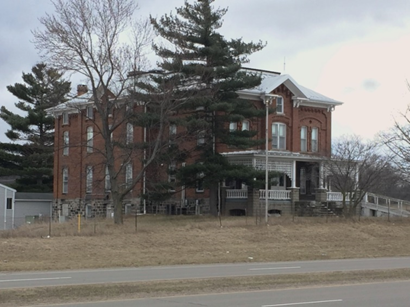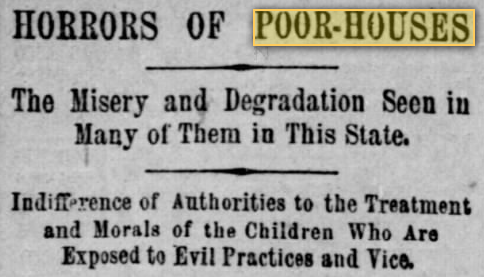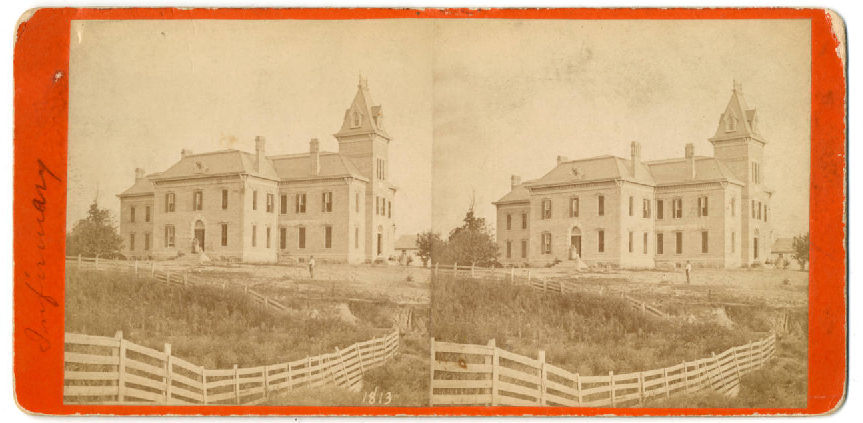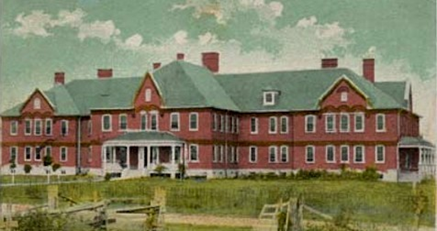
The Steuben County Asylum near I-69 in northeastern Indiana represents two contrasting ideals of poverty care. On the one hand, this imposing building on the rural landscape embodied the modern ideal of an end to poverty through scientific principles. In spite of the U.S. industrial economy of the later 19th century, marked by frequent panics and recessions, a new poor care system held out the hope that all indigent persons could be retrained and readied to work in the modern industrial world. The new system would provide a safety net supporting those through the hard years and would help impoverished people develop improved habits in a healthy and orderly atmosphere. On the other hand, this building symbolized failure and loss of place in the community. To be a resident of this facility required separation from society and often induced a lifelong stigma of shame.
These institutions represented both a severe solution meant to frighten the “lazy” into working harder and a belief in a safety net to support those living on the margins. [1] This was especially important in an era when layoffs were not supplemented by benefits like workers compensation. Across rural America, there was fear associated with the various names for asylums: almshouses, county farms and infirmaries, poor farms, county homes, workhouses, and “the pogey.”

Traditional poor relief (after private charities and local churches were exhausted) fell to local government. This was called “outdoor relief” because the poor or destitute were helped where they lived. To contain costs, the sheriff might “warn out” (or throw out) potential pauper residents to discourage poor people from staying there. Officials often employed this method to keep immigrants, especially the Irish, from settling in their town.
If the family could not care for an indigent resident, a landowner might take that person in on the lowest bid for room and board. By the 1820s, this informal arrangement was rapidly supplanted by an increasingly standardized system recognizing one place as a county poorhouse. The professionalization of these institutions focused on isolating each class of patient from what social reformers thought was the cause of their ailments or bad habits. The system was intended to instill a culture of order on the disorder of their lives. The enforced order would help cure the issues they faced. However, most residents used the farm only for periodic stays during times of unemployment and sickness.
In line with the rest of the nation, Indiana initiated its statewide system of county poor asylums.[2] In 1821, the state legislature approved Indiana’s first poorhouse in Knox County. Following the national standards for poorhouse improvements, promoted in prescriptive literature, many counties built what were called “model homes” by the later nineteenth century. These were modern buildings constructed to meet the current standards of that time. These asylums even provided libraries for residents to use in preparation for a changed life outside the asylum.[3]

Many rural almshouses were working farms, providing food for residents and a profit to the county government. The Democrat newspaper of Huntington County praised its superintendent in 1871 for keeping the farm as an “almost self-sustaining . . . charitable institution.” Efficiency and thrift were valued far higher than any other management trait.[4] These practices led to abuses of a very vulnerable group in society. To create a more orderly life for their residents, almshouses increased the level of isolation and separation in the homes. This policy is reflected in the houses’ physical form as it changed during the 19th century.
The Democrat provided a brief glimpse into the Huntington County almshouse during February of 1871. The paper listed 18 assorted inmates, but ten or twelve more typically resided there during the year. Most residents were temporally admitted during sicknesses and job slowdowns. Most poorhouses apparently hosted a few long-term residents and sometimes children were born there too. The farm around the almshouse provided work for residents capable of manual labor. One resident at the Huntington Almshouse was the full-time farm hand. Others worked on the farm or in the almshouse kitchen.[5]
Between 1830 and 1900, four stages in almshouse design demonstrated a stronger commitment to scientific poor care. The first stage involved converting a portion of a private house to accommodate paupers placed in the home owner’s care. The owners made no effort to separate the residents, and they were assigned farm work, as able, to help earn their keep. The famous 1872 poem by Will Carleton “Over the Hill to the Poor House” was inspired by his experience at just such a home in Hillsdale, Michigan. The lack of family support, as well as old age temporarily landed elderly mothers in the poor house.[6]
In the second stage, the county purchased a farm to use for the care of the poor. Other buildings might be constructed for dorm facilities for the majority of the residents.
The next stage was the first real attempt at building a custom facility for poor care. The Steuben County Asylum, built in 1885, appears to match this third stage. The strong center area indicates there was a public entrance with rooms for the County Superintendent of the Poor. There is room enough to separate men from women and to create the ordered environment that could be both helpful and oppressive.

The fourth stage is the full scale, scientifically approved poor house. As can be seen in the illustration above this facility is a massive element in the landscape. The very obvious three-part construction is easy to recognize. Some of you will have seen buildings like this around rural Indiana. They seem out-of-place among local farms. They may be marked by a road name such as Asylum Road or County Farm Road. The well-used 1911 textbook, The Almshouse Construction, and Management (written in Indiana) noted that asylums must be near the center of the region they serve, allow for complete segregation of the sexes, provide an abundance of sunlight and fresh air, and be designed for convenient access for administrators to the whole house. [7]
They are designed to house men and women in completely separate wings with public space in a center section. Usually, the County Superintendent of the Poor lived in the upstairs of the center section. Larger homes had infirmaries for men and for women. This feature became more common in the early 20th century as the almshouse became more of an old age home rather than a place of refuge from destitution.

When I first started researching this theme I interviewed staff at the Steuben County Asylum, which had been completely converted to a senior rest home. The problem was that many elderly residents refused to consider living there out of the memory of what that building had once meant.[8] Even in the 1980s, seniors related residency in the poorhouse with a loss of freedom and personal dignity. The company managing the care facility failed to grasp the public memory of the County Asylum on that generation. Ironically, the current generation of seniors (Baby Boomers) might laugh at residing in a former poorhouse perhaps as a way of poking fun at their elders’ fears.
County poorhouses should remain a visual reminder of the hazards inherent in reform efforts. Even with good intentions, abuses of vulnerable people occurred. The poorhouse had little to regulate it except mixed national ideals and local attitudes. Torn between purposes of punishment and rescue, poorhouses failed to cure poverty. The complexity of poverty caused reformers and politicians endless pains. We might gain some comfort that citizens and politicians before us found poverty as difficult to manage as we do now.
[1] David Wagner, The Poorhouse: America’s Forgotten Institution, (Lanham MD: Rowman & Littlefield Pub., 2005), 19.
[2] Kayla Hassett, “The County Home in Indiana: A Forgotten Response to Poverty and Disability,” (Masters Thesis, Ball State University, May 2013), 13.
[3] See report by Henry N. Sanborn, “Institution, Libraries: The Outlook in Indiana” Forty-Third Annual Meeting Conference of Charities and Correction. (Indianapolis, IN 1916), 367-371.
[4] “The County Alms-House Its General Condition-The Number and Character of its Inmates,” The Democrat, (Huntington, Indiana), February 2, 1871, accessed www.poorhousestory.com.
[5] Ibid.
[6] See Jerome A. Fallon, The Will Carleton Poorhouse: A Memorial to a Man, a Dwelling, and a Poem, (Hillsdale: Hillsdale Historical Society, 1989), 22-23.
[7] Alexander Johnson, The Almshouse Construction and Management (New York: Russell Sage Foundation, 1911), 8.
[8] Staff Steuben County Asylum interview by author, Fall 1994.
Further Reading
- Hassett, Kayla. “The County Home in Indiana: A Forgotten Response to Poverty and Disability.” Masters Thesis, Ball State University, May 2013.
- Katz, Michael B. In the Shadow of the Poorhouse: A Social History of Welfare in America. New York: Basic Books, Inc., 1986.
- Thomas D. Mackie, “Over the Hill to the Poorhouse: A Glimpse at the County Farms of Southern Michigan, 1850s-1920s.” PAST, 21 (1998).
- Rothman, David J. The Discovery of the Asylum: Social Order and Disorder in the New Republic. (Revised Ed) Boston: Backbay Books, 1990.
- Wagner, David, The Poorhouse: America’s Forgotten Institution. Lanham, MD: Rowman & Littlefield Inc.,2005.
- A private research web page titled Poorhouse Story provides images, primary sources, and readings for poorhouses and related agencies around the United States. They can be accessed at http://www.poorhousestory.com.
